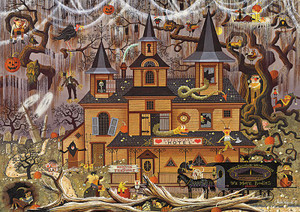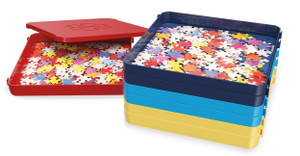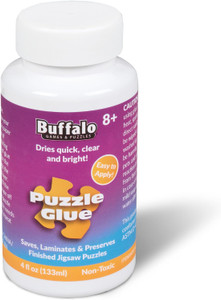Posted by Buffalo Games on May 17th 2022
Are Jigsaw Puzzles Addictive?
If you've ever muttered, "Just ten more minutes and then I'll stop, I swear..." while huddled over a jigsaw puzzle, you may be a jigsaw addict. But don't worry, you're in good company.
Whether you've completed a handful of jigsaw puzzles or hundreds, you probably find it difficult to tear yourself away from a work in progress. But why is that? What is it about jigsaw puzzles that keep you coming back for more? Keep reading to learn why jigsaw puzzles are so addictive and why that might not be such a bad thing.
The Physiological Process of Addiction
Typically, when we talk about addiction, we're talking about drugs or alcohol, but humans can become addicted to just about anything, including sugar, caffeine, exercise, and yes, even puzzles.
The two major players in addiction are the neurotransmitters dopamine and serotonin. They are both mood regulators, but dopamine is closely related to the pleasure and reward centers of your brain. When you do something you enjoy, your brain releases a small amount of dopamine, giving you a euphoric feeling.
Your body remembers which activities cause a spike in dopamine and seeks them out more in the future. The more you indulge in these dopamine-releasing activities, the more your brain wants them. This is how both positive and negative habits are formed.
Luckily, jigsaw puzzles don't come with the adverse health effects of most addictive substances. This is because they don't alter your brain chemistry in such a way that you become dependent on puzzles for dopamine. Instead, they just give you a little extra boost.
In fact, a puzzle addiction may just sharpen your mental acuity and lower your risk for several cognitive disorders.
Why Are Jigsaw Puzzles Addictive?
Any lifelong puzzle lover will tell you that they're addictive. But now that you know a little bit about how addiction works, you can understand why jigsaw puzzles are so addictive. Your brain doesn't only release dopamine when you complete a puzzle — it also releases dozens of little doses of dopamine along the way.
This mood-boosting ability, along with several other benefits, is what makes jigsaw puzzles so addictive and keeps millions of people hooked. Below are several reasons why jigsaw puzzles of every size make you feel so good.
They Engage Your Full Brain
Most activities engage one side of your brain at a time, but solving puzzles calls on several different skills that engage your entire brain. The right side of your brain focuses on creative tasks, while the left side of your brain handles logic and reasoning.
The visual-spatial reasoning skills that jigsaw puzzles require call upon your right brain, while the problem solving and concentration engage your left side. This not only feels good but also helps sharpen several cognitive skills.
There's a Clear Goal
The human brain loves to have a goal to work toward. Breaking out a jigsaw puzzle can scratch this itch. When you start a new puzzle, you know exactly what you're working toward, and you can devise a strategy to get there. This is why jigsaw puzzles for adults can help you feel grounded, purposeful, and driven when you start feeling aimless in life.
Having a clearly defined goal also makes it more satisfying when you place the last piece.
They Give You a Sense of Accomplishment
There's no denying that it feels good to get something done. Even smaller, 300-piece puzzles give you an incredible sense of accomplishment when you finish them. After you place the last piece, you get to take a step back, admire the complete puzzle, and say, "Yeah, I did that." This triggers the reward center in your brain, releasing dopamine and encouraging your brain to do more puzzles.
You're in Control
The hectic world around you can make you feel small and helpless at times. If you feel like you lack control in your everyday life, turning a messy pile of jigsaw pieces into a work of art can give you a sense of control and order. After all, you're in charge of exactly where everything goes and how you approach the puzzle.
This sense of control was part of the reason jigsaw puzzles skyrocketed in popularity during the COVID-19 pandemic. Many people felt helpless to the chaos around them as COVID-19 spread to every corner of the world, but jigsaw puzzles were a consistent source of peace and control.
A Meditative Distraction
Many people have trouble meditating because they have trouble totally clearing their brains. But for puzzlers, thumbing through pieces, sorting them into different categories, and finding their home in the larger picture is a form of meditation.
Once you find your groove in a puzzling session, you can't help but let all of the other thoughts in your mind fall by the wayside. As a result, you tend to forget about the bad day you just had or the upcoming interview you're anxious about. All of the stressors in your life seem to just melt away while you're in the "puzzle zone."
Diving into a 1000-piece puzzle is a great way to escape reality for a few hours. It can translate to a better sense of well-being and improved focus and concentration in other areas of your life.
You See Constant Progress
With puzzles, it's easy to get hung up on the pile of unplaced pieces, but placing just a few pieces can inch you closer to your goal in a measurable way. For example, with 500-piece puzzles, you complete 2% of the puzzle by placing just five pieces where they belong.
Even though you have to tackle jigsaw puzzles one piece at a time, you can see tangible progress with every piece you place. And each time a piece snaps into place, your brain gets a little hit of dopamine.
You may be asking yourself right about now, "Is anyone safe from puzzle addiction?" Unfortunately, due to dangerously high levels of fun and fulfillment, once you pick up jigsaw puzzles as a hobby, it's unlikely you'll be able to quit it. So you might as well pick out your next puzzle now.


















































